| |
Spanish |
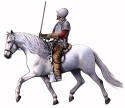 |
Spanish-Norman
This large strong horse carried medieval
knights into battle. It was hardy, courageous, powerful,
and quick to respond to the rider's commands. The Spanish
brought them to the New Worlds, where these superb warhorses
were used by the Conquistadors.
|
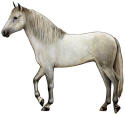 |
Andalusian
One of the oldest and purest breeds.
The introduction of firearms required a lighter, more agile
cavalry horse, so the Spanish began importing these versatile
horses.
They were especially well-suited for herding cattle.
|
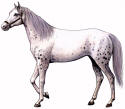 |
Spanish Jennet
This distinctively spotted horse is shown in
prehistoric cave paintings. In the Middle Ages, the
Spanish Jennet Horse (Pinto Paso or Paso Tiger Horse)
reflected his lofty Spanish heritage in his crisp, smooth
gait, his proud and elegant carriage, and in his brilliant
colors and flashy patterns. He was the mount of choice of all
European nobility. |
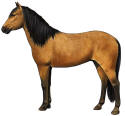 |
Spanish Barb
Also
called the Spanish colonial horse has an
ancient origin. He is the result of crossing the African Barb,
or Berber horse with the resident horse of the Iberian
Peninsula after the Moors invaded Spain in 711 AD. The
Spanish brought them to the new world for their soldiers and
work their ranches. |
| |
English |
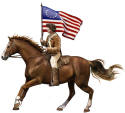 |
Thoroughbred
This superior breed of racehorses was developed
around 1700 in England from imported Arabian stallions and
English mares. .Thoroughbred racing in North America began
with an "English style race" held at Annapolis, Maryland in
1745. |
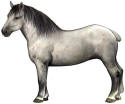 |
Breton
The Breton is used for heavy draft and farm work. The breed dates
back at least four thousand years. Some maintain it came from
Asia and others believe it comes from smaller horses that were
bred and improved by Celtic warriors on their conquest of what
is now Great Britain. |
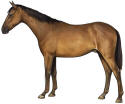 |
Galloway
The Galloway was a small, compact
horse that originally came from Scotland. They were gentle,
easy to ride and never tired and were know for being good
pacers. They were often used for racing. It is the ancestor of
the American Saddlebred horse |
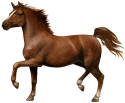 |
Hackney
The Hackney is a dynamic, high-stepper with two
branches -- the horse and the pony -- both bred specifically
for their brilliant performance in harness. It was developed
in Great Britain in the early 18th Century from the Darley
Arabian through his son, Flying Childerns that foaled in 1715. |
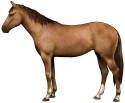 |
Hobbie Horse
The Hobby was a popular riding
horse In the Late Middle Ages. They were sometimes hobbled to
control their gait, which is what may have given rise to the
name. They were used for border patrol, but were often
used for recreational riding, which became known as a hobby.
They inspired the toy horse that carry their name..
|
| |
French |
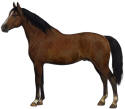 |
Normandy
The horse of Normandy,
France dates back over 800 years. They were big, powerful
warhorses and were imported as draft horse. They provided
bloodlines for many modern breeds, but the original Normandy
horse is now extinct. |
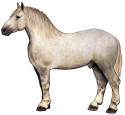 |
Percheron
The typical old-style Percheron (Percheron postier)
was a big grey harness horse famous for his very useful
ability to trot fast and long, while puling a heavy load. They
were used in Candada to pull heavy sleds |
| |
Dutch |
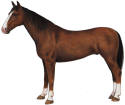 |
Gelderland
The Gelderland, also known as the
Gelderlander, is a warm blood horse which originated in the
sandy, mid-eastern province of the same name in the
Netherlands. |
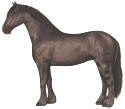 |
Friesian
The Friesian Horse originated in Friesland, one of
twelve provinces of the the Netherlands. It dates back to 500
BC. In 1625 the Dutch brought them to New Amsterdam, now New
York City. It was a good all-purpose horse that could be used
for riding and draft work. |
| |
German |
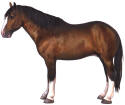 |
Destrier / Shire
Destrier is an historical term for a knight’s
war horse. When not fighting they were used to carry war gear.
William Penn brought them into his Pennsylvania colony in the
early 1700s for use as draft horses. The modern day Shire
descends from it. |
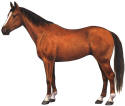 |
Holstein
The Holstein horse / Holsteiner is the result
product of systematic breeding dating back to the thirteenth
century. It comes from the Schleswig-Holstein province of
Germany. It was valued by German farmers for its strength,
steadiness and reliability. |
| |
Other |
|
 |
Arabian
Arabians are one of the oldest
horse breeds in the world. They originated in the Middle East
and spread westward across North Africa. The first
purebred was imported into England in 1683. A stallion
was brought to Virginia in 1725. It sired over 300
foals. |
 |
Norwegian Fjord
Swedes and Finns brought the fjord horse. Its
ancestors date back to the Vikings. They are light and fast
enough to be a good riding and driving horse, but yet strong
enough for heavy work, such as plowing the fields or pulling
timber. |
 |
Swedish
In 1638 the New Sweden Company created the
first permanent settlement of Delaware. It brought with it a
small compact, agile draft horse ideally suited to moving
heavy loads in confined spaces. |
|
|
All Images copyright Feenixx Publishing.
All right reserved. May not be used without prior written
consent. |